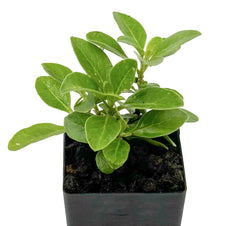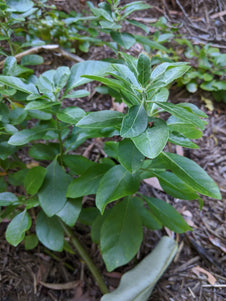





















Ashwagandha/Indian Ginseng
Ashwagandha/Indian Ginseng
- In stock, ready to ship
- Inventory on the way

Usually available: All year
Life cycle: Perennial
Height: 80cm - 1m
Position: Full sun
Soil preference: Well drained
This is how we pack and send your Herb Plants to all states except TAS & WA
You will receive
- 1 Ashwagandha/Indian Ginseng Herb Plant in a 50 X 75mm tube - General growing instructions
All of our Herb Plants are grown organically with certified organic potting mixes and fertilizers
Botanical Name: Withania somnifera
Withania somnifera is a small shrub growing up to 1 meter high and 75cm wide. The ovate leaves are about 8cm by 5cm at the widest point, tapering to the end. The central vein is prominent and the sides of the leaf fold in slightly towards the centre. The pale green flowers are held in an olive green calyx which surrounds the berry/fruit when the flower falls away, as the berry ripens the calyx browns and shrivels revealing the red fruit. Both the stem and leaves have a downy, grey sheen produced by a covering of tiny hairs. The fruit is a bright red and the seeds are tiny and brown.
Withania is from the Solanaceae or nightshade family and is also known as Indian Ginseng, ashwagandha, poison gooseberry or winter cherry in Australia (not to be confused with Physallis alkekengi). The species name ‘somnifera’ means sleep-inducing in Latin. The alternative name ashwagandha is derived from Sanskrit, in particular ‘ashva’ meaning ‘horse’ and ‘gandha’ meaning ‘smell’. The root of the plant is said to have a strong horse-like smell, resulting in the name. Indian Ginseng is a name derived from Ayurvedic medicine, where the plant holds the same degree of prestige as ginseng does in China. The plant is thought to be native to the drier regions of India and Nepal, with cultivation occurring in India.
Growing Conditions
WIthania prefers to inhabit warm, sheltered places with a preference for full sun. Dappled shade, such as that found in lightly treed woodlands is tolerated, but complete shade is not suitable. In its natural environment, Withania grows in shallow, rocky ground and prefers moist but well-drained soil. As long as there is good water supply after seeding, the plant should do well with natural rain unless it is very hot. It will do well in poor soils and most soil types are tolerated quite well. In some temperate areas, this plant may grow as an annual, due to intolerance of frost. Seed germinates quickly in spring and the plant will flower and fruit within the growing season. Withania can be subject to several pests and diseases such as stem and root rot. However, overall it is considered quite easy to grow and in some areas of NSW and SA, it is an uncommon weed.
Medicinal Uses
Withania somnifera is not commonly known in Australia, but is held in high esteem by herbal medicine practitioners. Withania has many uses in traditional herbal medicine, Ayurvedic and African traditional medicine. It is said to work by calming the brain, lowering blood pressure, reducing pain and inflammation, and altering the immune system. It is also used as an adaptogen to help the body cope with the stresses of daily life, as a general tonic said to prevent the symptoms of aging and as an agent to help improve the ability to think more clearly. The seeds are said to be diuretic and hypnotic.
More specifically, the chemical constituents include alkaloids, steroidal lactones including tropine and cuscohygrine. The leaves contain steroidal lactones, but the long tuberous roots are also used for traditional medicine. Ayurvedic medicine uses the berries and leaves applied externally to tumours, tubercular glands, carbuncles and ulcers. The roots are used to prepare ashwagandha, which has been used for many purposes, including arthritis, backache, skin conditions, asthma, liver disease, anxiety, insomnia, menstrual problems and induction of abortion.
Several studies have supported claims that the plant does possess benefits, including anti-inflammatory, anti-oxidant, anti-stress, immunomodularatory, rejuvenating benefits and has a beneficial effect on the endocrine, CNS and cardiopulmonary systems. However, the mechanisms of action are not fully understood for this plant and scientific evidence is very limited.
This plant contains chemicals that interact with many medications, so caution should be exercised. People with autoimmune disorders may find that this plant may encourage immune activity. Therefore increased symptoms may result if they are also taking medications to moderate immune response related to their disorder. It also interacts with the thyroid hormone and may increase thyroid activity. If individuals are also taking a thyroid supplement, then hyperthyroid symptoms may develop during this period.
Up to two weeks prior to surgery ingestion of this plant should be avoided due to potential effects or dampening of the central nervous system. The chemicals in the plant may also induce drowsiness, so avoid when taking sedatives or other medications that cause sleepiness due to risk of excessive doses. This may include common medications like hay-fever remedies. It is possible that chemicals found in the plant may irritate the gastrointestinal system. Additionally, pregnant and breast feeding women should avoid ingesting any part of this plant.
Culinary Uses and Other Uses
Withania berries may be used as a substitute for rennet in cheese making. The fruit is also rich in saponins and may be used as a soap substitute. The leaves are also used as an insect repellent.
Ashwagandha powder and ashwagandha root can be used to brew tea and added to baking and smoothies.
All information provided on this website is for informational purposes only. Please seek professional advice before commencing any treatment.





